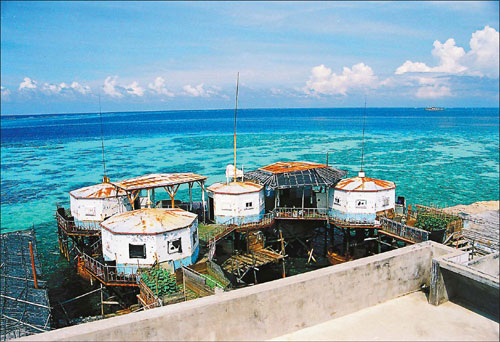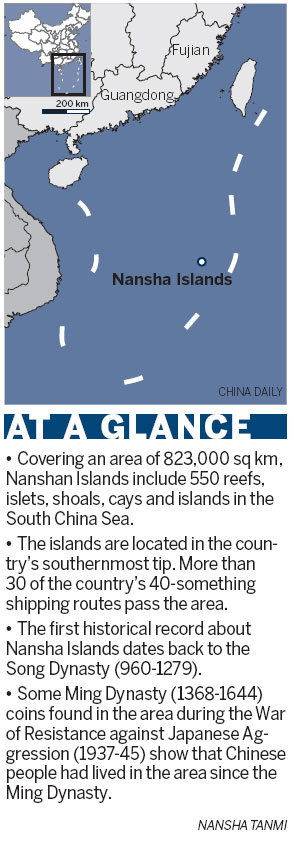
 'Taken 2' grabs movie box office crown
'Taken 2' grabs movie box office crown
 Rihanna's 'Diamonds' tops UK pop chart
Rihanna's 'Diamonds' tops UK pop chart
 Fans get look at vintage Rolling Stones
Fans get look at vintage Rolling Stones
 Celebrities attend Power of Women event
Celebrities attend Power of Women event
 Ang Lee breaks 'every rule' to make unlikely new Life of Pi film
Ang Lee breaks 'every rule' to make unlikely new Life of Pi film
 Rihanna almost thrown out of nightclub
Rihanna almost thrown out of nightclub
 'Dark Knight' wins weekend box office
'Dark Knight' wins weekend box office
 'Total Recall' stars gather in Beverly Hills
'Total Recall' stars gather in Beverly Hills
Island exploration
Updated: 2012-07-17 09:37
By Yang Guang (China Daily)
|
||||||||
 |
|
A garrison overlooking the crystal blue waters of Nansha Islands' Jimei Reef. Photos Provided to China Daily |

A former People's Daily military reporter provides his thoughts on Nansha Islands in a new book. Yang Guang reports.
The shape of China's territory has long been described as a rooster. But former military reporter and editor of People's Daily Zhu Sixiong believes the shape is more like a torch after visiting the Nansha Islands in the South China Sea.
Surrounded by rich fishing grounds and potentially huge gas and oil deposits, the Nansha Islands is also referred to as the second Persian Gulf.
In June, the State Council approved the establishment of Sansha, a prefectural-level city that will administer the Xisha, Zhongsha and Nansha island groups and their surrounding waters in the South China Sea.
Having boarded all the reefs garrisoned by the People's Liberation Army (PLA) in 2010, Zhu gives his view in the book An In-depth Exploration of the Nansha Islands. It comprises first-hand stories, together with People's Daily reports on the Nansha Islands from 1946 to the present.
"The Nansha Islands are one of those rare places that will stay in your memory for a lifetime, even if you step on it just once," Zhu says.

At the invitation of the PLA Navy, Zhu set off from the South Sea Fleet's headquarters in Zhanjiang, Guangdong province, and sailed for 60 hours on a supply ship to reach the Nansha Islands, in April 2010.
Zhu says it was a dream come true. He explains that he had a chance to conduct interviews on Xisha Islands for 10 days in 1993, which impressed him and sowed the seed of wanting to return.
During his 13-day stay, he boarded large and small reefs and talked face-to-face with 27 officers and soldiers.
"The high temperature, humidity and salinity on the islands pose a severe physical challenge," he says, "not to mention the mental pressure resulting from the peculiar location of the islands and the monotonous life."
He says even a dog he met was affected. "It was particularly docile, looked up at strangers and wagged its tail. But its actions were slower and its eyes more blurred than its counterparts on the mainland."
The PLA soldiers plant purslane to liven up the environment. For Zhu, the flowers represent the soldiers' spirit - the stronger the sun shines, the better the flowers blossom.
"I saw and heard a lot, and was deeply moved by the suntanned faces on the lonely reefs. Compared to them, whatever I do in my comfortable office in Beijing seems like luxury and insignificant."
When he searched for more information about Nansha after returning, he found that most of the information comprised dry facts about history, diplomacy and administrative jurisdiction.
"It occurred to me that I could publish a book to inform more people about the real situation of Nansha, through the stories of our PLA guards," Zhu says.
Some Southeast Asian countries are laying claim to the Nansha Islands. The PLA has been stationed there since 1988.
In Zhu's opinion, the country's military presence manifests sovereignty over the area, while civilian development - currently limited to commercial fishing - should be increased.
Most Viewed
Editor's Picks

|

|

|

|

|

|
Today's Top News
Health new priority for quake zone
Xi meets US top military officer
Japan's boats driven out of Diaoyu
China mulls online shopping legislation
Bird flu death toll rises to 22
Putin appoints new ambassador to China
Japanese ships blocked from Diaoyu Islands
Inspired by Guan, more Chinese pick up golf
US Weekly

|

|






